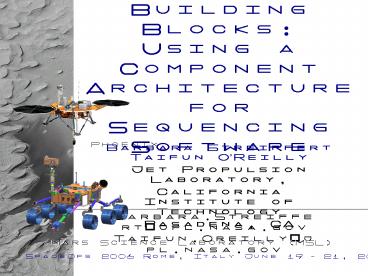Sequence System Building Blocks: Using a Component Architecture for Sequencing Software - PowerPoint PPT Presentation
1 / 17
Title:
Sequence System Building Blocks: Using a Component Architecture for Sequencing Software
Description:
Using a Component Architecture for Sequencing Software. Barbara Streiffert. Taifun O'Reilly ... Barbara.Streiffert_at_jpl.nasa.gov. Taifun.Oreilly_at_jpl.nasa.gov. Phoenix ... – PowerPoint PPT presentation
Number of Views:44
Avg rating:3.0/5.0
Title: Sequence System Building Blocks: Using a Component Architecture for Sequencing Software
1
Sequence System Building Blocks Using a
Component Architecture for Sequencing Software
Phoenix
- Barbara Streiffert
- Taifun OReilly
- Jet Propulsion Laboratory,
- California Institute of Technology
- Pasadena, CA
Barbara.Streiffert_at_jpl.nasa.gov
Taifun.Oreilly_at_jpl.nasa.gov
Mars Science Laboratory (MSL)
2
Agenda
- Introduction
- Next Generation Uplink Planning System (NGUPS)
Ensemble - Multi Mission Planning and Sequencing
- In-Situ Collaboration
- Conclusion
3
Introduction
Current Project Characteristics
- Spacecraft Complexity
- Multiple processors (Instruments, Attitude
Control, Command/Data Handling) - Commands with more autonomy
- Desire for more data return for science
Current Goals for Operations
- Faster more efficient ground operations that are
more cost effective - Low risk ground operations
Aids for Ground System Software
- New Software Methodologies and Tools
- Agile Development
- Rich Client Platform/Frameworks
- Components/Features
- Refactoring
4
Next Generation Uplink Planning System (NGUPS)
Ensemble
- NGUPS Ensemble
- Funded by the Mars Technology Program
- Goals
- To utilize new technology for the Mars missions
- Infuse proven technology into project software
- To promote a more efficient ground system for the
various Mars missions in particular Mars Science
Laboratory. - Performed a study of Mars Exploration Operations
(MER) - Determined
- Need for a more cohesive ground system
- Too many User Interfaces representing the same
data differently - Desire to reuse sequences
5
Next Generation Uplink Planning System (NGUPS)
Ensemble
NGUPS Ensemble
- The new software methodologies and tools were
used to implement the proposed MSL ground system
including - Agile Development
- Rich Client Platform (Eclipse)
- Components/Features (groups of components or
legacy tool) - Refactoring (primarily of legacy tools)
- Use of Java utilities including Java Messaging
Service
6
Next Generation Uplink Planning System
MSL Ground System Software
External Model Application Interface
User Interface Activity Planning
Activity Resources Targets
Interactive Timeline Table Editing
Eclipse RCP
Constraint Propagation
External Model Application Interface
Not Used by MSL
Editors
Modeling
3rd Party Software
7
Multi Mission Planning Sequencing (MPS)
MPS
- Funded by Multi Mission Ground Systems and
Services - Goals
- Provide Reusable Ground System software
- Provide Project adaptation capability (mechanism
for project dependent aspects) - Provide multi mission aspects in software (i.e.
ability to check flight rules) - Provide Projects a lower cost for Ground System
development (only one organization implements,
documents and tests) - Holds User Group meetings to determine project
needs - Recent meetings concluded
- Need for common input (XML)
- Need for utilizing laptops (Linux environment)
- Need for refactored Activity and Sequence
modeling to exclude User Interface
8
Multi Mission Planning Sequencing (MPS)
MPS
- The new software methodologies and tools were
used to upgrade the MPS ground system tools
including - Rich Client Platform (Eclipse including the
Eclipse Bridge for legacy tools) - Components/Features (groups of components or
legacy tool) - Refactoring (primarily of legacy tools)
- Use of Java utilities such as Java Messaging
Service (JMS), Java XML Binding for input, etc.
9
Multi Mission Planning and Sequencing
Multi-Mission Ground System Software
Client
Web Service
Activity Dictionary Editor
Sequence Modeler Activation
Eclipse RCP
JMS Messaging
Sequencing Model Plugin
Constraint Propagation
Activity Modeling
Activity User Interface
10
In-Situ Collaboration
NGUPS, Ensemble MPS
- The three groups have common lists of new
capabilities with the exception of using Agile
Development - Rich Client Platform (Eclipse including the
Eclipse Bridge for legacy tools) - Components/Features (groups of components or
legacy tool) - Refactoring (primarily of legacy tools)
- Use Java Utilities such as Java Messaging Service
(JMS), Java XML Binding for input, etc. - Agile Development (NGUPS Ensemble)
This Ground System was needed for the upcoming
In-Situ missions of Phoenix and MSL so In-Situ
Collaboration was born
11
In-Situ Collaboration
In-Situ Ground System Software
External Model Application Interface
Sequence Modeling
expansion, models, rules
Configuration/ Communication
External Model Application Interface
12
In-Situ Collaboration
Challenges
- Four teams involved
- NGUPS (represents MSL)
- Ensemble
- MPS
- Phoenix
- Work and Schedules must be coordinated
- Prioritization includes four separate teams
- Phoenix and MSL have different schedules with
different need dates - All four teams have their own meetings
- Work must be allocated to various teams
13
In-Situ Collaboration
Solutions
- Tasks have been allocated based on each missions
priorities and requirements. - Team members work for multiple teams.
- Example Taifun OReilly (a co-author of this
paper) works ½ time for MPS and 1/5 time for
NGUPS. - Selected System Engineers and Developers attend
MPS, NGUPS and Phoenix meetings. - Example I work for NGUPS but I attend the
Phoenix activity dictionary meetings, the NGUPS
activity dictionary meetings and the In-Situ
status meeting. - Prioritization has been based on need date.
Phoenix launches in 2007 and MSL launches in
2009. However, MSLs focused technology money
ends FY06. - Work has been allocated to various teams based on
the type of work
14
Project Specific/Project Independent
Joint In-Situ Project
MSL
Phoenix (PHX)
Project Specific Activities Flight
Rules Mission Rules Commands Sequences Project
Models
Project Specific Activities Flight
Rules Mission Rules Commands Sequences Project
Models
Multi-Mission Planning and Sequencing
(MPS) Project Independent XML
Readers/Writers Flight Rule Checking
Infrastructure Activity Infrastructure
Expansion Sequence Infrastructure
Expansion Command Handling Checking Resource
Checking Infrastructure Constraint Propagation
Infrastructure
15
Samples of the Software
Timeline Editing and Display
Downlink Browsing
Note No real data has been used in these displays
16
Samples of Software
Activity Type Editing
Target Selection
Note No real data has been used in these displays
17
Conclusion
The Ultimate Goal On-Line Shopping for a GDS
GDS Tool Shopping
Sequence Modeling
Timeline Table Editing
Mobility/Arm Sequencing
Activity Modeling

